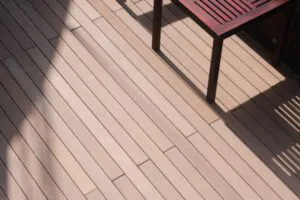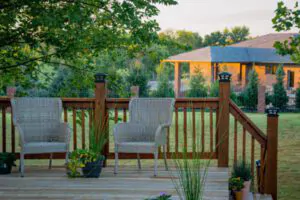Building a floating deck over a concrete slab is an innovative way to enhance your outdoor living space. A floating deck, known for its versatility and design freedom, differs from traditional decks because it’s not anchored to the ground or a building.
Instead, it uses materials like composite planks that are rot-proof and require no protective finish, making it both durable and low maintenance. This method of decking stands out by offering quick installation with minimal disruption, as the need for digging or extensive removal of existing structures is eliminated thanks to preformed blocks.
The choice to construct a floating deck over concrete comes with numerous benefits including ease for do-it-yourself enthusiasts looking to add value without seeking professional help every step of the way.
It opens up possibilities for eye-catching designs in various outdoor settings such as balconies, pool areas, patios, boardwalks, and garden pergolas. Its construction is simplified through the use of 2×4 joists placed 16 inches apart in the center providing ample support while allowing creative flexibility.
Moreover, this approach transforms any space into an appealing retreat with minimal effort required for upkeep once built—making it an attractive option for enhancing multi-story facilities or breathing new life into old balconies without heavy demolition work.
Explore how easy it can be!
Key Takeaways
- Building a floating deck over a concrete slab saves time and is easy to do, making it perfect for DIY enthusiasts. You don’t need to dig deep footings like traditional decks, which means you can avoid complex construction work.
- Floating decks are versatile and enhance any space, whether it’s a balcony in a high-rise building or your backyard patio. They provide an eye-catching design that can transform outdoor areas into inviting spaces for relaxation or entertainment.
- Using pressure-treated wood or composite materials for the deck ensures durability against weather conditions and minimizes maintenance efforts. These materials resist rot and decay, keeping the deck looking great with little upkeep.
- Floating decks offer flexibility in design and placement around your yard or over existing structures like concrete slabs. This allows homeowners to customize their outdoor living spaces according to their preferences and available space.
- The process of building a floating deck involves gathering specific supplies such as pressure-treated lumber, composite boards, deck blocks, PVC trim, concrete screws, decking fasteners, drills, saws, and measuring tapes. With these tools and materials ready at hand makes starting this project accessible for those who wish to upgrade their outdoor space efficiently.
What is a floating deck?
A floating deck is a structure built on top of a concrete slab without penetrating the surface. It differs from traditional decks as it doesn’t require footings and can be customized to fit any space, using materials like composite decking and joist hangers.
Definition
A floating deck, often called a ground-level or freestanding deck, stands alone without being attached to any building or structure. This means the entire structure supports itself and doesn’t rely on being bolted to the home.
It gets its name because it appears to “float” above the ground or a concrete slab, unlike traditional decks that are anchored directly.
Building these decks involves laying decking boards over joists supported by beams and blocks instead of drilling into an existing foundation. Using materials like pressure-treated lumber or composite decking ensures durability against weather conditions.
The design makes use of joist hangers to keep everything in place, offering flexibility in location and style that fixed decks can’t match.
How it differs from traditional decks
Floating decks stand out because they do not require deep footings like their traditional counterparts. Instead, they rest on concrete blocks known as deck blocks that are placed above ground.
This setup means the process to build them is generally quicker since you skip the time-consuming task of digging and setting in-ground concrete piers. The unique approach allows for a more flexible placement around your yard or over existing structures like concrete slabs.
Traditional decks often need extensive support and anchoring to the ground, involving drills and various drill bits to secure into place. On the other hand, floating decks distribute weight differently, relying on pressure-treated wood and deck blocks for stability rather than being fixed directly into the earth with risers.
This method reduces potential water intrusion issues by keeping the structure above ground level, ensuring better durability against moisture damage without needing deeper footings, which can become more expensive as height increases.
Materials needed
To begin building a deck over a concrete slab, gather some specific supplies. You’ll need pressure-treated lumber or composite boards for the base and surface. These materials resist rot and stand up against weather well.
Deck blocks are critical too, especially if your ground is not even; they support the structure without digging. Remember, PVC trim will help give your project a finished look while concrete screws keep everything secure.
Next, ensure you have decking fasteners to assemble the pieces tightly together. If your design calls for elevation changes or footings due to height regulations, plan these components carefully.
Tools like drills, saws, and measuring tapes are essential in cutting boards to size and securing them properly. With these items ready, you’re set to transform that old concrete into a stunning outdoor space.
Benefits of Building a Floating Deck Over Concrete Slab
Building a floating deck over a concrete slab offers quick and easy installation, making it perfect for balconies or multi-story facilities. This DIY-friendly solution requires low maintenance and boasts an eye-catching design that enhances outdoor spaces.
Quick and easy installation
Building a floating deck over a concrete slab provides quick and easy installation, perfect for those seeking an efficient and hassle-free solution. With pressure-treated wood as the primary material, this endeavor promises straightforward construction involving minimal complexities.
The simplified process not only saves time but also ensures a user-friendly approach, making it accessible to DIY enthusiasts or individuals looking for convenient deck-building options.
Internet browsers like Google Chrome or web search engines such as Bing are entities useful in navigating instructional resources related to this undertaking.
Great for balconies or multi-story facilities
Floating decks are a fantastic option for balconies or multi-story facilities due to their quick and easy installation. People living in apartments can appreciate the added curb appeal that these decks provide, enhancing the overall aesthetic of the building.
The DIY-friendly nature of floating decks makes them an ideal choice for those looking to undertake a project themselves, and they offer low maintenance requirements, contributing to their allure for busy urban dwellers.
Moreover, their eye-catching design allows for creative freedom and flexibility in adapting them to various spaces.
For apartment complexes seeking bespoke deck solutions, floating decks stand out as an attractive option that not only adds visual appeal but also provides practical usage options such as outdoor seating areas or communal lounging spaces.
Additionally, these decks present a cost-effective way to enhance properties without extensive construction work involved.
DIY-friendly
Building a floating deck over a concrete slab is a fantastic DIY project, especially for those who enjoy working on their own outdoor spaces. This type of decking does not require the same level of precision and attachment to the house as traditional decks do, making it much more approachable for beginners.
With readily available materials like pressure-treated wood and easily adjustable deck blocks, building this kind of deck is achievable for many DIY enthusiasts.
Low maintenance
A floating deck requires minimal maintenance once constructed. This makes it a popular choice for outdoor spaces due to its ease of care and long-term durability. The low maintenance associated with a floating deck is attributed to the use of pressure-treated wood, which wards off insect damage and prevents decay, ensuring the deck remains in top condition for an extended period.
The minimal upkeep required for a floating deck underpins its appeal as a cost-effective and practical solution for those seeking a hassle-free yet visually appealing addition to their outdoor areas.
Eye-catching design
Eye-catching design is a hallmark of floating decks, drawing attention and adding visual interest to any outdoor space. The use of pressure treated wood or composite decking can create a stunning focal point that elevates the overall aesthetic appeal of your property.
The unique construction allows for creative customization, enabling you to incorporate distinct patterns, shapes, and even integrated lighting to further enhance the deck’s allure.
The versatile nature of floating decks makes them suitable for various settings, whether it’s a sleek modern look or a more rustic charm.
The contrast between natural materials like wood and the surrounding environment can be visually striking while seamlessly blending with landscaping features such as gardens or water features.
Uses for Floating Decks
Floating decks serve various functions in different settings. They are perfect for creating a serene and relaxing atmosphere on balconies, adding an aesthetic touch to pool areas, providing a cozy outdoor space on the back patio, offering a picturesque path as boardwalks, or highlighting the beauty of nature with garden pergolas.
These versatile structures seamlessly blend with diverse environments and elevate the outdoor experience.
By integrating these uses into your surroundings, you can transform spaces into inviting retreats while enjoying the benefits of a floating deck over concrete slabs.
Balconies
Cantilevered balconies provide improved aesthetics and unobstructed views, creating an elegant and floating effect. Floating decks offer an excellent way to enhance these spaces, camouflaging concrete slabs with eye-catching designs.
This approach not only adds visual appeal but also provides a practical option for multi-story facilities or high-rise buildings. The quick and easy installation of floating decks makes them an ideal choice for transforming balconies into versatile outdoor living areas that require minimal maintenance.
By integrating the principles of constructing a deck over a concrete slab, this method offers enhanced beauty while providing durable and functional outdoor spaces that seamlessly blend with existing structures like cantilevered balconies.
Pool areas
Floating decks are versatile and can be used to create a stunning pool area. Their quick installation and DIY-friendly nature make them an attractive choice for enhancing the space around your pool.
Whether it’s next to an in-ground pool or as part of a multi-story facility, these decks are perfect for adding a touch of style and functionality to your outdoor oasis. With meticulous planning and expert guidance, you can transform your pool area into an inviting space that complements both its surroundings and your lifestyle.
When it comes to designing a floating deck for your pool area, consider incorporating Dek-blok piers made of concrete. These sturdy supports provide the foundation necessary for ensuring the structural integrity of the deck adjoining your pool.
Back patio
Transform your back patio into a stylish and functional space with a custom-built floating deck. Say goodbye to the uninspiring concrete slab and welcome a stunning outdoor area crafted to suit your needs.
A floating deck provides an ideal platform for hosting gatherings, enjoying family meals, or simply unwinding in the open air. Whether you envision it as an extended entertainment area or a tranquil oasis, a floating deck on your back patio adds flair and versatility to your outdoor living space.
Crafted specifically for your backyard area, our team at [Company Name] specializes in creating bespoke decks tailored towards enhancing your outdoor experience. With meticulous attention to detail and expert guidance every step of the way, we ensure that your new back patio will become the perfect setting for memorable moments and relaxation alike.
Boardwalks
Boardwalks are an excellent addition to any outdoor space, offering a charming pathway that enhances the overall aesthetic. Whether winding through a garden or leading to a picturesque view, boardwalks provide both functionality and visual appeal.
They are particularly beneficial for navigating wetlands, as they minimize impact on delicate ecosystems while allowing pedestrians to enjoy the natural surroundings. Constructing a floating deck over concrete slabs can serve as an innovative solution for creating eco-friendly boardwalks in areas with sensitive ecosystems.
Building a durable and attractive boardwalk involves understanding the intricacies of wetland preservation, ensuring minimal disturbance to the surrounding environment. By utilizing appropriate materials and techniques, such as using composite wood instead of traditional lumber or installing helical piers rather than concrete footings for stability, these walkways can be built sustainably while providing long-lasting functionality.
Garden pergola
A garden pergola can be a stunning addition to your outdoor space when anchored to a floating deck. The stable foundation provided by the floating deck removes the need for setting posts in concrete, making it an attractive and practical option.
When considering building a pergola on a floating deck, expert guidance is essential to ensure proper anchoring methods for stability and safety.
Ensuring that the construction of the pergola on a floating deck adheres to proper techniques is crucial. Expert tips and resources are available to guide you through this process, making it achievable even for those without specialized knowledge or experience in construction.
How to Build a Floating Deck Over Concrete Slab
To build a floating deck over a concrete slab, start by ensuring the area is clean and level. Use tools such as a shovel for excavation, a hammer drill for drilling into the concrete, and joist hangers to secure the deck’s frame.
Lay out the decking boards and attach them securely with screws after aligning them properly. Double-check all measurements and ensure that everything is fitted snugly before enjoying your new outdoor space!
Preparation and safety precautions
Before starting the construction, it’s essential to obtain all necessary permits from the local building authority. Contact a professional engineer or contractor to inspect and ensure that the concrete slab is in good condition for supporting a floating deck.
Excavation work will be needed, so be prepared for labor-intensive tasks and always wear appropriate safety gear such as gloves, goggles, and sturdy footwear before handling any tools or chemicals.
Now let’s dive into some careful planning – identify all underground utilities like gas lines and electrical wiring before breaking ground on your project. Even though we can anticipate potential obstacles during this phase of your project, consulting with industry professionals is advisable to make sure you’re aware of intricate complexities when digging near these vital systems.
Tools and materials needed
For building a floating deck over a concrete slab, you will need essential tools including a level, miter or circular saw, and hammer drill to ensure accuracy and stability. It’s advisable to have safety gear such as goggles and gloves during the construction process.
In terms of materials, consider using composite decking for durability, concrete blocks for supporting the structure, and weather-resistant stains to preserve the deck’s appearance against various elements.
These primary tools and materials are crucial for achieving a sturdy yet visually appealing floating deck that complements both residential and commercial spaces without overwhelming maintenance requirements.
Step-by-step process
To build a floating deck over a concrete slab, start by clearing the area then lay out the deck blocks to begin framing. Position and level the frame before adding the remaining joists for stability.
Secure the frame and prepare the ground for installing concrete blocks. Lay composite decking over concrete without sleepers for a fresh look. Plan and lay out a DIY floating deck while accounting for a sloping yard, and foundation options, and utilizing expert guidance and resources.
After preparing the site, building a sturdy frame is essential to support your floating deck structure. Once in place, laying down composite decking can add an eye-catching element to your outdoor space without needing conventional sleepers or extra support structures.
Expert guidance and resources
Building a floating deck over a concrete slab may seem daunting, but with expert guidance and resources, the process becomes more manageable. Industry professionals offer valuable tips on constructing decks over concrete, providing clear instructions to guide you through each step.
Companies specializing in decking services provide bespoke solutions tailored towards your project’s specific requirements. Additionally, TuffBlock deck support blocks deliver a robust foundation for building floating decks without the need for complex digging or pouring of concrete.
Expert resources extend beyond physical tools; composite decking materials and innovative methods are also part of this ever-evolving realm. These resources underpin the world of modern deck construction, unlocking secrets to efficiently build eye-catching and durable structures.
Conclusion
In summary, constructing a floating deck over a concrete slab offers numerous benefits. It provides an easy and quick installation process, making it ideal for balconies or multi-story facilities.
This DIY-friendly option requires low maintenance while offering an eye-catching design. Whether for a pool area, back patio, boardwalk, garden pergola, or balcony, the uses are versatile and practical.
With this solution in your toolkit and the right materials at hand, you can successfully expand your outdoor living space with an attractive and functional floating deck!
FAQs
1. Will a floating deck over concrete last long?
Yes, a floating deck built over concrete can last many years with proper maintenance.
2. Can I build a floating deck by myself?
Yes, you can build a floating deck yourself if you have basic DIY skills and tools.
3. Does building a floating deck require a lot of materials?
You’ll need some specific materials like wood planks, screws, and supports, but it’s not overly complicated or excessive.
4. Will the floating deck damage my concrete slab?
No, building a floating deck correctly does not damage the underlying concrete slab.
5. Can I put furniture on my floating deck?
Yes, you can place furniture on your floating deck to create an enjoyable outdoor living space.






